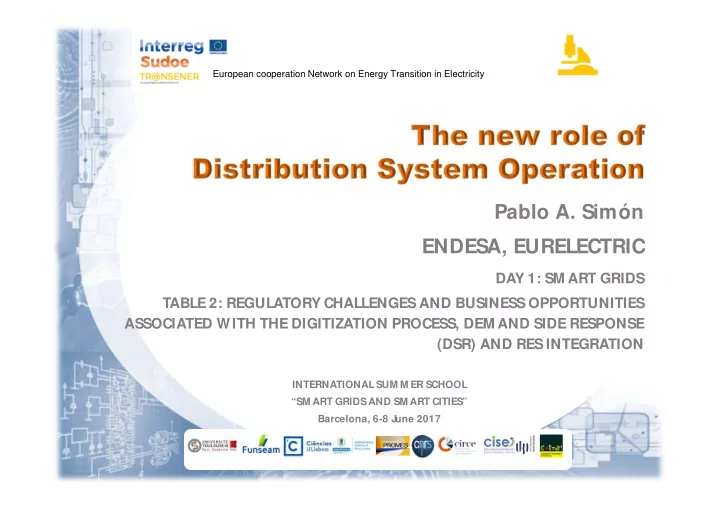

European cooperation Network on Energy Transition in Electricity Pablo A. Simón ENDESA, EURELECTRIC DAY 1: SM ART GRIDS TABLE 2: REGULATORY CHALLENGES AND BUSINESS OPPORTUNITIES ASSOCIATED WITH THE DIGITIZATION PROCESS, DEM AND SIDE RESPONSE (DSR) AND RES INTEGRATION INTERNATIONALSUM M ER SCHOOL “SM ART GRIDSAND SM ART CITIES” Barcelona, 6-8 J une 2017
Introduction Old roles vs new roles of DSOs What’s new Conclusion 2
(1) Issues/ targets: Climate change Fuel dependency (2) Energy transition Legal tools: Directives + regulations (First) Package (2003/ 54) Second Package (2009/ 72) Winter Package (Clean Energy for all Europeans) (3) Framework and (main) key principles: RES integration Consumer-centric approach Competitive market based mechanisms No discrimination 3
…in energy transition: (E)volution instead of (re)volution. (1) Keeping the targets of the activity: • High standards of quality • Cheapest price (cost effectiveness) (2) DSOs’ adaptation: • Planning and operation distribution network • Neutral/ Independent market facilitator: no interferences in the market 4
From vertically integrated undertakings…
… to democratization of the energy. (* ) The utility of the future. J .I. Pérez Arriaga 6
Question 1: (* ) The Future Role of DSOs. A CEER Conclusions Paper Ref: C15-DSO-16-03 13 July 2015 How do the new roles stem from the existing DSO’s structure? Question 2: How will the existing top-down energy distribution electricity infrastructure cope with all the foreseen changes? 7
According to some authors, changes are envisaged in: • (1) DSOs’ business environment • (2) DSOs’ role • (3) DSO’s ownership • (4) DSO’s regulatory framework 8
DERs (Distributed Energy Resources) • Flexibility services/ active costumers (to support network operation) (* ) • Small scale/ dispersed RES generation • Self consumption • Transport electrification/ EV & Cold ironing (* ) • Electric Storage (* ) • Power to heat • Energy efficiency services Issues: • Ownership & management of metering equipment • Data handling • TSO/ DSO coordination (* ) 9
How do DSOs cope with all of these disruptions? • Off-grid installations / grid defection • Demand uncertainty • Technology / standards Business model • Regulatory risks Network codes vs • M icrogrids, nanogrids technical feasibility • Local energy communities • Organized prosumers • Real estate developers • Residential and industrial facility managers • PV producers / retailers / suppliers, aggregators • J oint ESCOs • EV Charging operators • Platforms and apps developers 10
Implementation (Clean Energy Legislative Package): - Prohibition on DSO ownership/ operation of energy storage - Prohibition on DSO ownership/ operation of electric vehicles’ charging infrastructure - Network planning and coordination (TSO/ DSO planning and operation coordination) Further clarification/ debate and some provisions must be explored. 11
(* ) European Energy Regulators’ White Paper # 3 Facilitating flexibility Sources of flexibility (top box) include power generation, storage and changes in demand, such as the turning down of consumption upon request. 12
Flexibility available options : • market-based procedures • direct contracts • connection agreements • network tariffs/ rules-based Only when network reinforcement is proven less efficient M arket standard products would be defined Regulators should ensure that DSOs incentives are not distorted 13
M arket impact Quality of supply impact 14
M arket price impact 15
Voltage regulation Substation Product quality impact Voltage regulation Substation Sparse generation G Self-consumption C Flex. demand 16
For the time being, DSOs must continue to manage their systems prudently and in the interest of their customers Accordingly, acquisition of any services be done by business-as-usual DSO procurement under NRA scrutiny TRANSPARENCY must be on the root of all the investment decision process 5 STEP PROCESS: 1. DSO identifies local distribution grid need 2. The DSO details the location, technical requirements (specification) 3. Following discussions with the NRA a tender/ procurement process may be launched. 4. If the market procurement is successful and cost effective, contractual agreements will be established within the regulatory framework. 5. If the market procurement is not successful, DSOs will have to address/ assess different alternatives such as network expansion, other flex assets, including developing storage facilities of their own. 17
Three pillars to achieve of Electro-M obility development (1) Public support: DSOs could (as in some countries T o reduce economic risks (customer and already do): companies) for EVs and infrastructure • Implement charging stations in those countries where there is no (2) Standardization and interoperability: market for mobility providers yet Common standards for infrastructure and • Only for public stations (fast and vehicles connection slow) Interoperability/ roaming of energy bills • Be the owner, the technical operators and providers of (3) Charging infrastructure metering services Increase the numbers of charging stations Build them in public, private and semi-public This should be places only temporarily 18
Smart EV charging: Actors and resource flows (* ) Driving integration. Regulatory responses to electric vehicle grow. Lab RM I. 19
Basic framework: (1) There should be a better network planning and coordination between network operators. (2) No submission but agreement in a regulated framework: coordination with each other. (3) M utual exchange of operational and contractual data Technical coordination in safeguarding cross border internal electricity market: transmission Network codes impacts: RfG / DCC / HVDC 20
M AIN TAKEAWAYS: (1) DSOs are ready to be the market facilitator (2) When the market does not exist, DSOs can contribute to its initial development (3) Clear regulatory framework should be enforce so as to minimize business risk (4) NRAs must have room enough to adapt the rules to every single M S. 21
Pablo A. Simón pablo.simon@enel.com Regulación ENDESA, S.A. 22
Recommend
More recommend